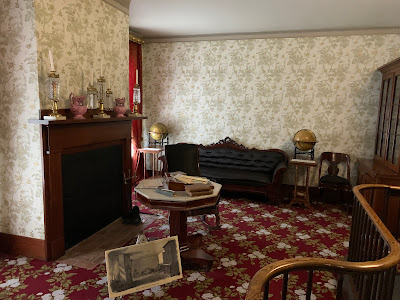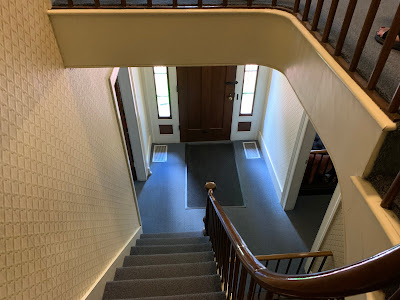Believe it or not, there was still more to learn about Abraham Lincoln. So we went back into downtown Springfield to see the house he and Mary purchased and proceeded to furnish in 1844 after the birth of their son, Robert,
The 1 1/2 story Greek Revival-style home met the family's needs at first but as the family grew, the Lincolns gradually enlarged the house to its current size. The most significant change was the addition of a full second story with 11-foot ceilings. These allowed for the incorporation of transom windows in the upstairs bedrooms to aid in ventilation during the hot summer months.
Obviously no construction cones in front when Abraham and Mary lived here
In this house, the Lincolns raised three more sons and mourned the passing of one of them. Considered by some to be indulgent parents, the Lincolns filled their home with toys, books, and various other articles for the education and entertainment of their children. Some of those artifacts remain in the home today.
The sitting room was a place for the family to talk, relax, and play games and was a focal point of family life. The young boys likely played with their father while Mrs. Lincoln made and mended her family's clothes.
One of the more expensive toys Lincoln purchased for his children was the stereoscope on the table, which allowed a pair of people to view three-dimensional photographs simultaneously. Mr. Lincoln purchased this stereoscope in the late 1850s.
The home was also a setting of key events in Mr. Lincoln's political career. He worked on his campaign strategy for the general election in this house. He left for Washington D.C. to begin his first presidential term with every intention of returning once he left office. This was not to be.
The front parlor was a luxurious space where the Lincolns would receive visitors to their home and entertain their guests in grand style.
Photos above the fireplace are originals of George and Martha Washington
Mrs. Lincoln made sure the family's finest furnishings were on display for all to see, the room still contains many original pieces of furniture from the Lincolns' time here. The room could be separated from the adjacent back parlor by means of a large wooden room divider or opened up to create a spacious formal parlor.
When both rooms were open the space could accommodate large groups of people. One such group was the Republican delegation that visited the home to offer Mr. Lincoln their party's nomination for the 1860 presidential campaign. The back parlor also served as Mr. Lincoln's private library and study.
The master bedroom features 11-foot ceilings and contains some original furniture owned by Lincoln, including his wardrobe, chest of drawers, and writing desk. The wallpaper is a reproduction of the pattern selected by Mary Lincoln for their bedroom.
The Lincoln bed
Abraham Lincoln's writing desk
One of the least known of Henry Clay's accomplishments is the influence on a young Abraham Lincoln. Lincoln once told a sculptor carving his likeness that he "almost worshipped Henry Clay". Clay was a strong advocate of a centralized federal government and may be one of the reasons that Lincoln would not allow the Union to dissolve.
Henry Clay on the left, Daniel Webster on the right
Above the mantle in Lincoln's bedroom
Adjacent to the master bedroom is a smaller room where Mrs. Lincoln could bathe and dress in private and where she sometimes slept when Mr. Lincoln worked late into the night. Younger sons Tad and Willie often slept on a trundle bed in the same room.
And then we saw the dining room.
The indoor kitchen with the original cast iron stove that Mary used. She loved this stove and wanted to keep it there for use when they returned to the home.
We stood at the back of the house and imagined what secrets were held behind the windows.
It was so interesting to see a photo of the house from about 1865.
Twenty-two years after Lincoln's 1865 assassination in Washington DC, eldest son Robert Lincoln relinquished the family's ownership of the home with the goal of increasing public access to this historic property as long as visiting the home was always free to the public. The home and the surrounding neighborhood officially became a National Historic Site in 1972 under the management of the National Park Service, which maintains the home to this day.






















More Lincoln---I am feeling envious!
ReplyDeleteThere is a lot to see.
Delete